Exploring the Effects of the Built Environment on Two Transfer Modes for Metros: Dockless Bike Sharing and Taxis
Abstract
1. Introduction
2. Literature Review
2.1. Metro Access with Cycling and Taxis
2.2. Effects of the Built Environment on Bike Sharing and Taxis
3. Materials and Methods
3.1. Case-Study Context
3.2. Data Collection
3.2.1. DBS and Taxi Raw Data
3.2.2. Built Environment Factors
3.3. Data Processing
3.4. Spatial Distribution of Two Modes
3.5. Models
4. Results
4.1. Variables
4.2. Model Results
5. Discussion
6. Conclusions and Recommendations
Author Contributions
Acknowledgments
Conflicts of Interest
References
- Cheng, Y.H.; Tseng, W.C. Exploring the effects of perceived values, free bus transfer, and penalties on intermodal metro–bus transfer users’ intention. Transport Policy 2016, 47, 127–138. [Google Scholar] [CrossRef]
- Ji, Y.; Fan, Y.; Ermagun, A.; Cao, X.; Wang, W.; Das, K. Public bicycle as a feeder mode to rail transit in China: The role of gender, age, income, trip purpose, and bicycle theft experience. Int. J. Sustain. Transp. 2017, 11, 308–317. [Google Scholar] [CrossRef]
- Zhou, S.; Ni, Y. Effects of Dockless Bike on Modal Shift in Metro Commuting: A Pilot Study in Shanghai. In Proceedings of the Transportation Research Board 97th Annual Meeting, Washington, DC, USA, 7–11 January 2018. [Google Scholar]
- Wu, S.-S.; Zhuang, Y.; Chen, J.; Wang, W.; Bai, Y.; Lo, S.-M. Rethinking bus-to-metro accessibility in new town development: Case studies in Shanghai. Cities 2019, 94, 211–224. [Google Scholar] [CrossRef]
- Yang, M.; Zhao, J.; Wang, W.; Liu, Z.; Li, Z. Metro commuters’ satisfaction in multi-type access and egress transferring groups. Transp. Res. Part D Transp. Environ. 2015, 34, 179–194. [Google Scholar] [CrossRef]
- Wang, J.; Liu, J.; Ma, Y.; Sun, F.; Chen, F. Temporal and Spatial Passenger Flow Distribution Characteristics at Rail Transit Stations in Beijing. Urban Transp. China 2013, 11, 24–33. [Google Scholar]
- Li, M.; Dong, L.; Shen, Z.; Lang, W.; Ye, X. Examining the Interaction of Taxi and Subway Ridership for Sustainable Urbanization. Sustainability 2017, 9, 242. [Google Scholar] [CrossRef]
- Martin, E.W.; Shaheen, S.A. Evaluating public transit modal shift dynamics in response to bikesharing: A tale of two U.S. cities. J. Transp. Geogr. 2014, 41, 315–324. [Google Scholar] [CrossRef]
- Feng, X. The current situation and countermeasures of the use of public bicycle in Xi’an. China Mark. 2016, 32, 180–181. [Google Scholar]
- Liu, Q. Study on the influencing of public bicycle user’s choice behavior in Jinhua city. Business 2016, 16, 62–63. [Google Scholar]
- Campbell, A.A.; Cherry, C.R.; Ryerson, M.S.; Yang, X. Factors influencing the choice of shared bicycles and shared electric bikes in Beijing. Transp. Res. Part C 2016, 67, 399–414. [Google Scholar] [CrossRef]
- Yu, S.; Zhang, X.; Zhao, J. Understanding the usage of dockless bike sharing in Singapore. Int. J. Sustain. Transp. 2018, 12, 1–15. [Google Scholar]
- Shaheen, S.; Nelson, C.; Apaar, B.; Adam, C. Chapter 13: Sharing Strategies: Carsharing, Shared Micromobility (Bikesharing and Scooter Sharing), and Innovative Mobility Modes. 2019. Available online: https://escholarship.org/uc/item/0z9711dw (accessed on 26 July 2018).
- Chen, P.; Liu, Q.; Sun, F. Bicycle parking security and built environments. Transp. Res. Part D Transp. Environ. 2018, 62, 169–178. [Google Scholar] [CrossRef]
- Lierop, D.; Grimsrud, M.; El-Geneidy, A. Breaking into Bicycle Theft: Insights From Montreal, Canada. Int. J. Sustain. Transp. 2014, 9, 12. [Google Scholar] [CrossRef]
- Mburu, L.; Helbich, M. Environmental Risk Factors influencing Bicycle Theft: A Spatial Analysis in London, UK. PLoS ONE 2016, 11, e0163354. [Google Scholar] [CrossRef]
- Du, M.; Cheng, L. Better Understanding the Characteristics and Influential Factors of Different Travel Patterns in Free-Floating Bike Sharing: Evidence from Nanjing, China. Sustainability 2018, 10, 1244. [Google Scholar] [CrossRef]
- Company, M. The research report on dockless bike sharing. Available online: https://mp.weixin.qq.com/s/4cDM6_5qFvqaIxafCXxaeg (accessed on 26 July 2018).
- Company, O. The research report on China’s dockless bike industry in 2017. Available online: https://wenku.baidu.com/view/c5c1fd0376232f60ddccda38376baf1ffc4fe3aa.html?rec_flag=default&sxts=1531712325722 (accessed on 12 February 2017).
- Shaheen, S.; Cohen, A. Shared Micromoblity Policy Toolkit: Docked and Dockless Bike and Scooter Sharing; 2019. Available online: https://escholarship.org/uc/item/00k897b5 (accessed on 26 July 2018).
- Gu, T.; Kim, I.; Currie, G. Measuring immediate impacts of a new mass transit system on an existing bike-share system in China. Transp. Res. Part A Policy Pract. 2019, 124, 20–39. [Google Scholar] [CrossRef]
- Gu, T.; Kim, I.; Currie, G. To be or not to be dockless: Empirical analysis of dockless bikeshare development in China. Transp. Res. Part A Policy Pract. 2019, 119, 122–147. [Google Scholar] [CrossRef]
- Qian, X.; Ukkusuri, S.V. Spatial variation of the urban taxi ridership using GPS data. Appl. Geogr. 2015, 59, 31–42. [Google Scholar] [CrossRef]
- Cheng, Y.H.; Liu, K.C. Evaluating bicycle-transit users’ perceptions of intermodal inconvenience. Transp. Res. Part A Policy Pract. 2012, 46, 1690–1706. [Google Scholar] [CrossRef]
- Ma, X.; Yang, M.; Ji, Y.; Jin, Y.; Tan, X. Understanding Bikeshare Mode as a Feeder to Metro by Isolating Metro–Bicycle Transfers from Smart Card Data. Transp. Policy 2018, 71, 57–69. [Google Scholar] [CrossRef]
- Arbis, D.; Hossein Rashidi, T.; Dixit, V.; Vandebona, U. Analysis and Planning of Bicycle Parking for Public Transport Stations. Int. J. Sustain. Transp. 2015, 10, 150817125034000. [Google Scholar] [CrossRef]
- Molin, E.; Maat, K. Bicycle parking demand at railway stations: Capturing price-walking trade offs. Res. Transp. Econ. 2015, 53, 3–12. [Google Scholar] [CrossRef]
- Caulfield, B.; Brick, E.; McCarthy, O.T. Determining bicycle infrastructure preferences—A case study of Dublin. Transp. Res. Part D Transp. Environ. 2012, 17, 413–417. [Google Scholar] [CrossRef]
- Jingxu, C.; Xuewu, C.; Wei, W.; Baol, F. The Demand Analysis of Bike-and-ride in Rail Transit Stations based on Revealed and Stated Preference Survey. Procedia-Soc. Behav. Sci. 2013, 96, 1260–1268. [Google Scholar] [CrossRef]
- Erdoğan, S.; Liu, C.; Ma, T. Bicycle Sharing and Transit: Does Capital Bikeshare Affect Metrorail Ridership in Washington, D.C. Transp. Res. Rec. J Transp. Res. Board 2015, 2534. [Google Scholar] [CrossRef]
- Ji, Y.; Ma, X.; Yang, M.; Jin, Y.; Gao, L. Exploring Spatially Varying Influences on Metro-Bikeshare Transfer: A Geographically Weighted Poisson Regression Approach. Sustainability 2018, 10, 1526. [Google Scholar] [CrossRef]
- Zhao, P.; Li, S. Bicycle-metro integration in a growing city: The determinants of cycling as a transfer mode in metro station areas in Beijing. Transp. Res. Part A Policy Pract. 2017, 99, 46–60. [Google Scholar] [CrossRef]
- Li, Y.; Zhu, Z.; Guo, X. Operating Characteristics of Dockless Bike-Sharing Systems near Metro Stations: Case Study in Nanjing City, China. Sustainability 2019, 11, 2256. [Google Scholar] [CrossRef]
- Yang, Z.; Franz, M.L.; Zhu, S.; Mahmoudi, J.; Nasri, A.; Zhang, L. Analysis of Washington, DC taxi demand using GPS and land-use data. J. Transp. Geogr. 2018, 66, 35–44. [Google Scholar] [CrossRef]
- Li, B.; Cai, Z.; Jiang, L.; Su, S.; Huang, X. Exploring urban taxi ridership and local associated factors using GPS data and geographically weighted regression. Cities 2019, 87, 68–86. [Google Scholar] [CrossRef]
- Wang, C.-H.; Chen, N. A geographically weighted regression approach to investigating the spatially varied built-environment effects on community opportunity. J. Transp. Geogr. 2017, 62, 136–147. [Google Scholar] [CrossRef]
- Cai, H.; Jia, X.; Chiu, A.S.F.; Hu, X.; Xu, M. Siting public electric vehicle charging stations in Beijing using big-data informed travel patterns of the taxi fleet. Transp. Res. Part D Transp. Environ. 2014, 33, 39–46. [Google Scholar] [CrossRef]
- Cardozo, O.D.; García-Palomares, J.C.; Gutiérrez, J. Application of geographically weighted regression to the direct forecasting of transit ridership at station-level. Appl. Geogr. 2012, 34, 548–558. [Google Scholar] [CrossRef]
- Kim, K. Exploring the difference between ridership patterns of subway and taxi: Case study in Seoul. J. Transp. Geogr. 2018, 66, 213–223. [Google Scholar] [CrossRef]
- Susan, S.; Adam, C.; Balaji, Y.; Sara, S. Mobility on Demand Operational Concept Report. 2017. Available online: http://innovativemobility.org/?project=mobility-demand-operational-concept-report (accessed on 26 July 2018).
- El-Assi, W.; Mahmoud, M.S.; Habib, K.N. Effects of built environment and weather on bike sharing demand: A station level analysis of commercial bike sharing in Toronto. Transportation 2017, 44, 589–613. [Google Scholar] [CrossRef]
- Faghihimani, A.; Eluru, N.; Elgeneidy, A.M.; Rabbat, M.; Haq, U. How land-use and urban form impact bicycle flows: Evidence from the bicycle-sharing system (BIXI) in Montreal. J. Transp. Geogr. 2014, 41, 306–314. [Google Scholar] [CrossRef]
- Zhao, J.; Wei, D.; Yan, S.; Zhu, Y. What influences Metro station ridership in China? Insights from Nanjing. Cities 2013, 35, 114–124. [Google Scholar] [CrossRef]
- Wang, X.; Lindsey, G.; Schoner, J.E.; Harrison, A. Modeling Bike Share Station Activity: Effects of Nearby Businesses and Jobs on Trips to and from Stations. J. Urban Plan. Dev. 2016, 142, 04015001. [Google Scholar] [CrossRef]
- Yang, W.; Chen, B.Y.; Cao, X.; Li, T.; Li, P. The spatial characteristics and influencing factors of modal accessibility gaps: A case study for Guangzhou, China. J. Transp. Geogr. 2017, 60, 21–32. [Google Scholar] [CrossRef]
- Wei, T.; Rui, C.; Yang, Y.; Zhou, B.; Li, Q.; Li, Q. Spatial variations in urban public ridership derived from GPS trajectories and smart card data. J. Transp. Geogr. 2018, 69, 45–57. [Google Scholar]
- Sun, F.; Chen, P.; Jiao, J. Promoting public bike-sharing: A lesson from the unsuccessful Pronto system. Transp. Res. Part D Transp. Environ. 2018, 63, 533–547. [Google Scholar] [CrossRef]
- Zhang, Y.; Thomas, T.; Brussel, M.; Maarseveen, M.V. Exploring the impact of built environment factors on the use of public bikes at bike stations: Case study in Zhongshan, China. J. Transp. Geogr. 2017, 58, 59–70. [Google Scholar] [CrossRef]
- Hu, L.; Sun, T.; Wang, L. Evolving urban spatial structure and commuting patterns: A case study of Beijing, China. Transp. Res. Part D Transp. Environ. 2018, 59, 11–22. [Google Scholar] [CrossRef]
- Company, M.; Institute, B.T.T.U.P.D. Sharing bicycles and urban development in 2017. Available online: http://www.199it.com/archives/581592.html (accessed on 20 April 2017).
- Mirkatouli, J.; Samadi, R.; Hosseini, A. Evaluating and analysis of socio-economic variables on land and housing prices in Mashhad, Iran. Sustain. Cities Soc. 2018, 41, 695–705. [Google Scholar] [CrossRef]
- Brons, M.; Givoni, M.; Rietveld, P. Access to railway stations and its potential in increasing rail use. Transp. Res. Part A 2009, 43, 136–149. [Google Scholar] [CrossRef]
- Institute, B.T. Beijing transport annual report 2017. Available online: http://www.bjtrc.org.cn/List/index/cid/7.html (accessed on 21 August 2018).
- Wu, X.; Lu, Y.; Lin, Y.; Yang, Y. Measuring the Destination Accessibility of Cycling Transfer Trips in Metro Station Areas: A Big Data Approach. Int. J. Environ. Res. Public Health 2019, 16, 2641. [Google Scholar] [CrossRef]
- Rastogi, R.; Rao, K.V.K. Travel Characteristics of Commuters Accessing Transit: Case Study. J. Transp. Eng. 2003, 129, 684–694. [Google Scholar] [CrossRef]
- Tran, T.D.; Ovtracht, N.; d’Arcier, B.F. Modeling Bike Sharing System using Built Environment Factors. Procedia CIRP 2015, 30, 293–298. [Google Scholar] [CrossRef]
- Xu, H.T.; Wu, H.; Fang, X.J.; Zhang, W.J. Finding Key Stations of Hangzhou Public Bicycle System by a Improved K-Means Algorithm. Appl. Mech. Mater. 2012, 209–211, 925–929. [Google Scholar] [CrossRef]
- He, T.; Wei, G.; Bo, Z.; Ke, L. A GPS Data Based Distributed K-Means for Cabstand Location Selection. In Proceedings of the 2017 International Smart Cities Conference (ISC2), Wuxi, China, 14–17 September 2017. [Google Scholar]
- Alexander, N. Bayesian Disease Mapping: Hierarchical Modeling in Spatial Epidemiology. J. Royal Stat. Soc. 2011, 174, 512–513. [Google Scholar] [CrossRef]
- Getis, A. Spatial Autocorrelation. In Handbook of Applied Spatial Analysis: Software Tools, Methods and Applications; Fischer, M.M., Getis, A., Eds.; Springer Berlin Heidelberg: Berlin/Heidelberg, Germany, 2010; pp. 255–278. [Google Scholar]
- Fan, Y.; Khattak, A.J. Urban Form, Individual Spatial Footprints, and Travel: Examination of Space-Use Behavior. Transp. Res. Rec. J. Transp. Res. Board 2008, 2082, 98–106. [Google Scholar] [CrossRef]
- Sun, Y.; Chao, G.; Li, J.; Li, W.; Ma, R. Examining urban thermal environment dynamics and relations to biophysical composition and configuration and socio-economic factors: A case study of the Shanghai metropolitan region. Sustain. Cities Soc. 2017, 40, 284–295. [Google Scholar] [CrossRef]
- Kutner, M.H.; Nachtsheim, C.J.; Neter, J. Applied Linear Regression Model. Technometrics 2004, 26, 415–416. [Google Scholar]
- Martens, K. The bicycle as a feedering mode: Experiences from three European countries. Transp. Res. Part D Transp. Environ. 2004, 9, 281–294. [Google Scholar] [CrossRef]
- Lin, J.J.; Zhao, P.; Takada, K.; Li, S.; Yai, T.; Chen, C.H. Built environment and public bike usage for metro access: A comparison of neighborhoods in Beijing, Taipei, and Tokyo. Transp. Res. Part D Transp. Environ. 2018, 63, 209–221. [Google Scholar] [CrossRef]
- Shaheen, S.; Cohen, A.; Farrar, E. Mobility on Demand: Evolving and Growing Shared Mobility in the Suburbs of Northern Virginia. In Implications of Mobility as a Service (MaaS) in Urban and Rural Environments; IGI Global: Hershey, PA, USA, 2020; pp. 125–155. [Google Scholar]
- de Souza, F.; La Paix Puello, L.; Brussel, M.; Orrico, R.; van Maarseveen, M. Modelling the potential for cycling in access trips to bus, train and metro in Rio de Janeiro. Transp. Res. Part D Transp. Environ. 2017, 56, 55–67. [Google Scholar] [CrossRef]
- Vandenbulcke, G.; Dujardin, C.; Thomas, I.; Geus, B.D.; Degraeuwe, B.; Meeusen, R.; Panis, L.I. Cycle commuting in Belgium: Spatial determinants and ‘re-cycling’ strategies. Transp. Res. Part A 2011, 45, 118–137. [Google Scholar] [CrossRef]
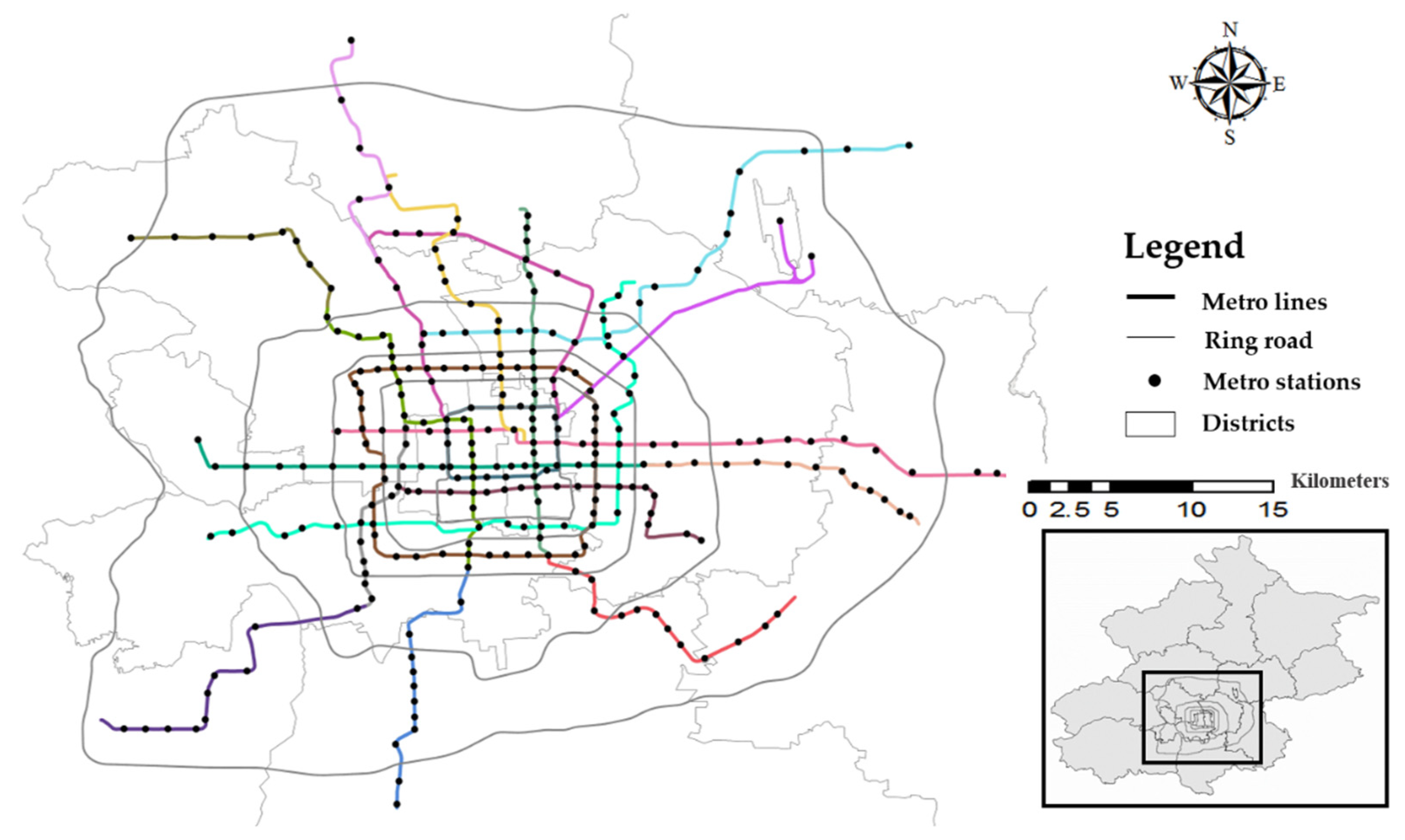
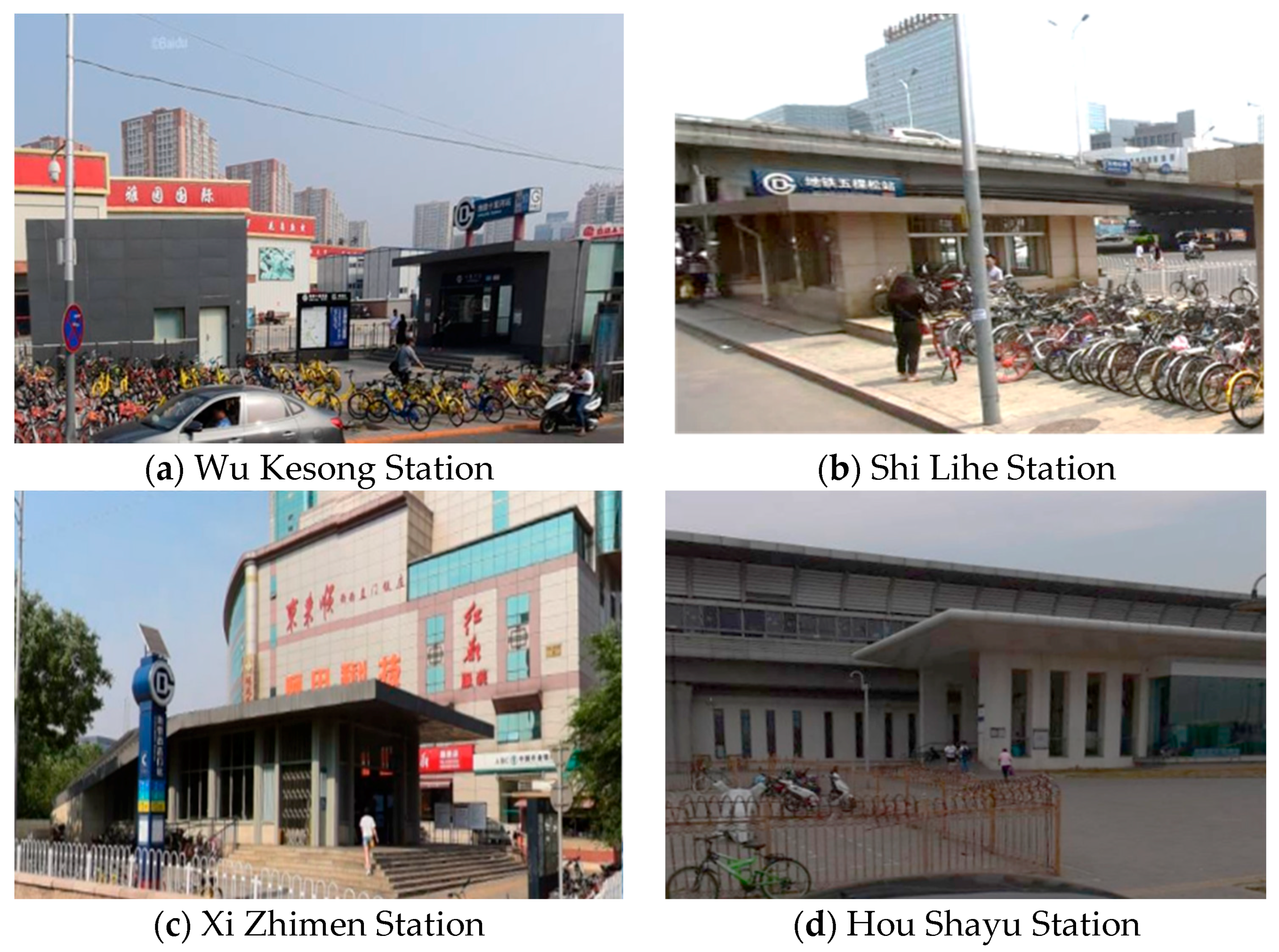
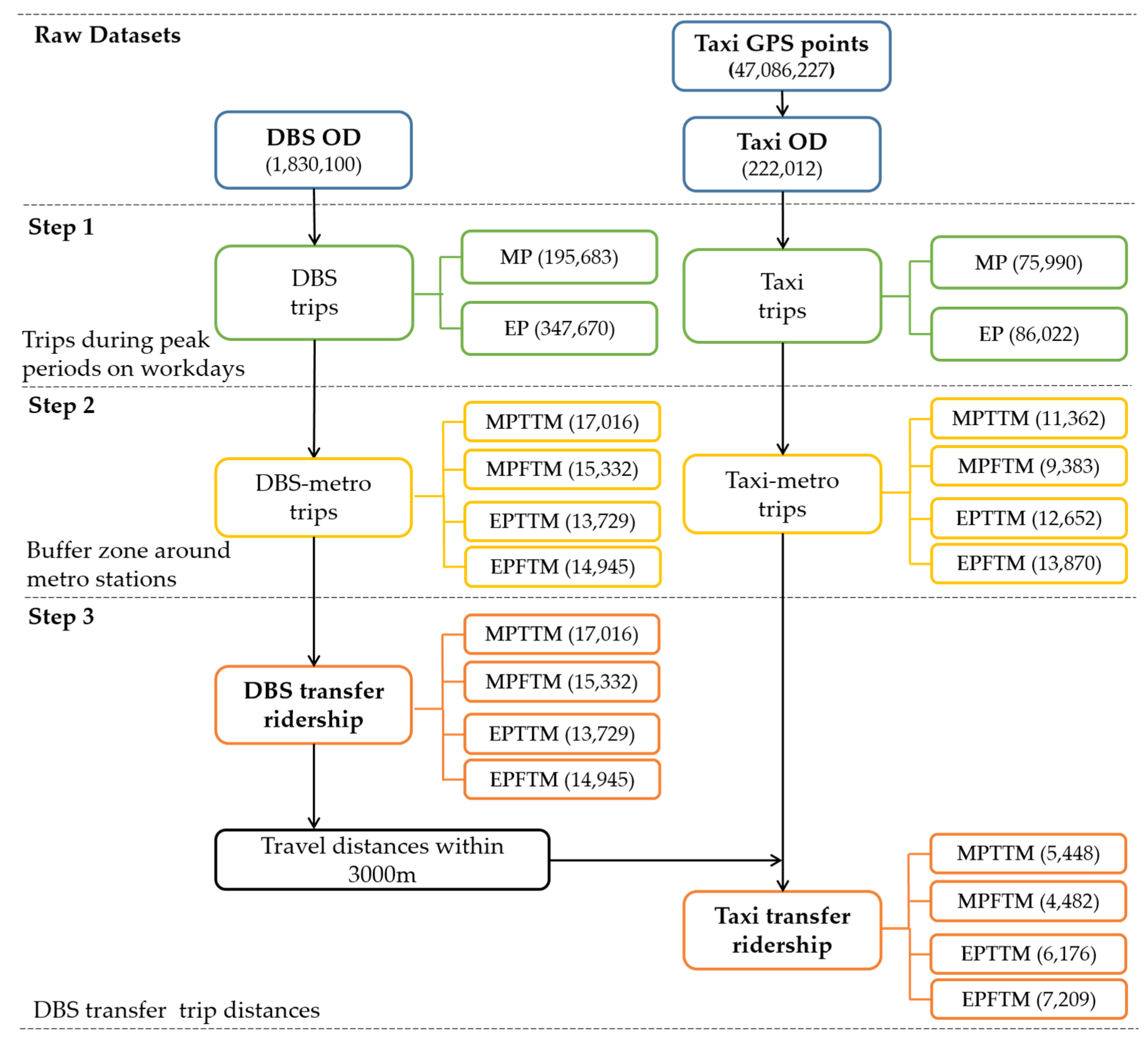
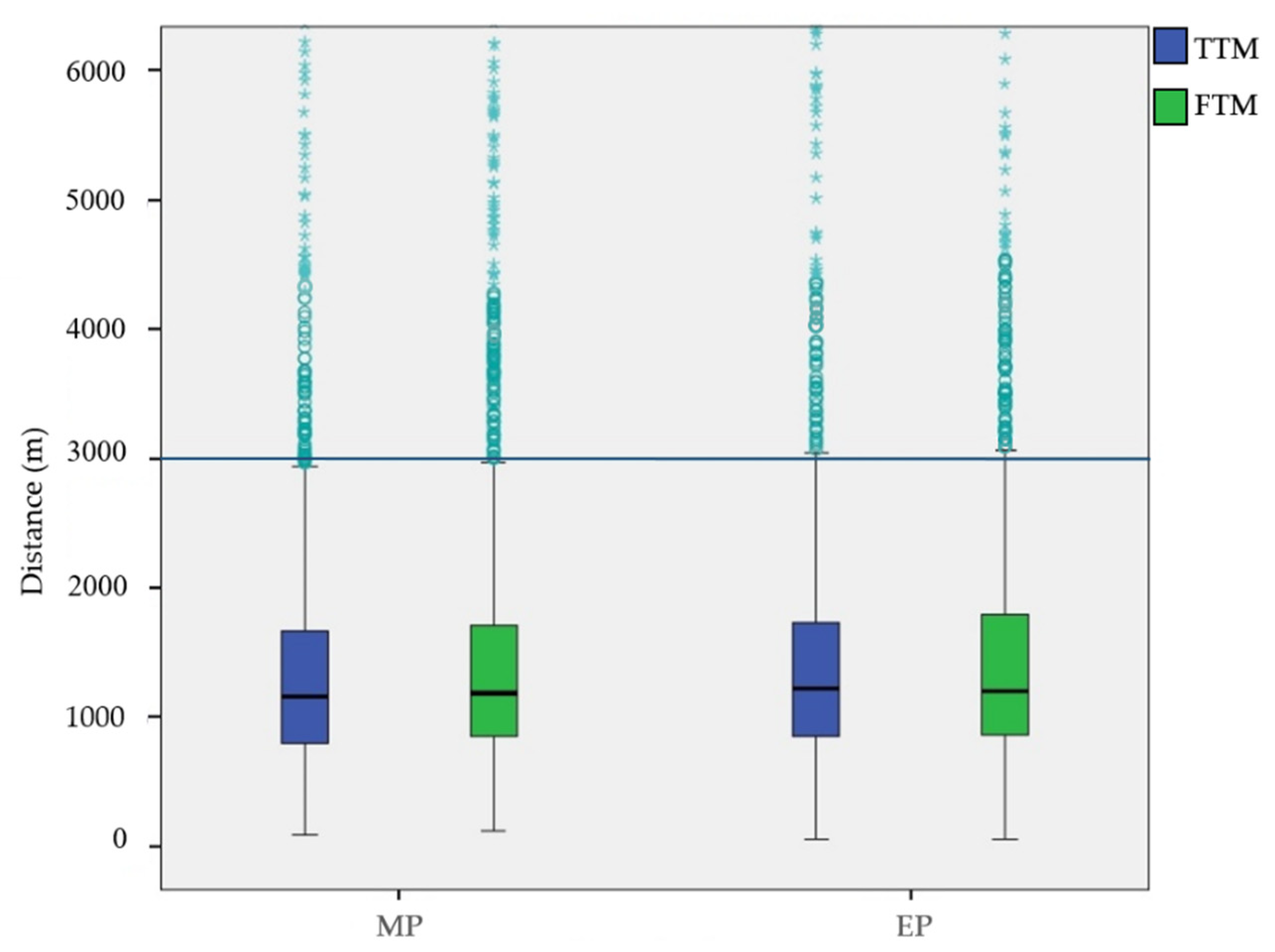
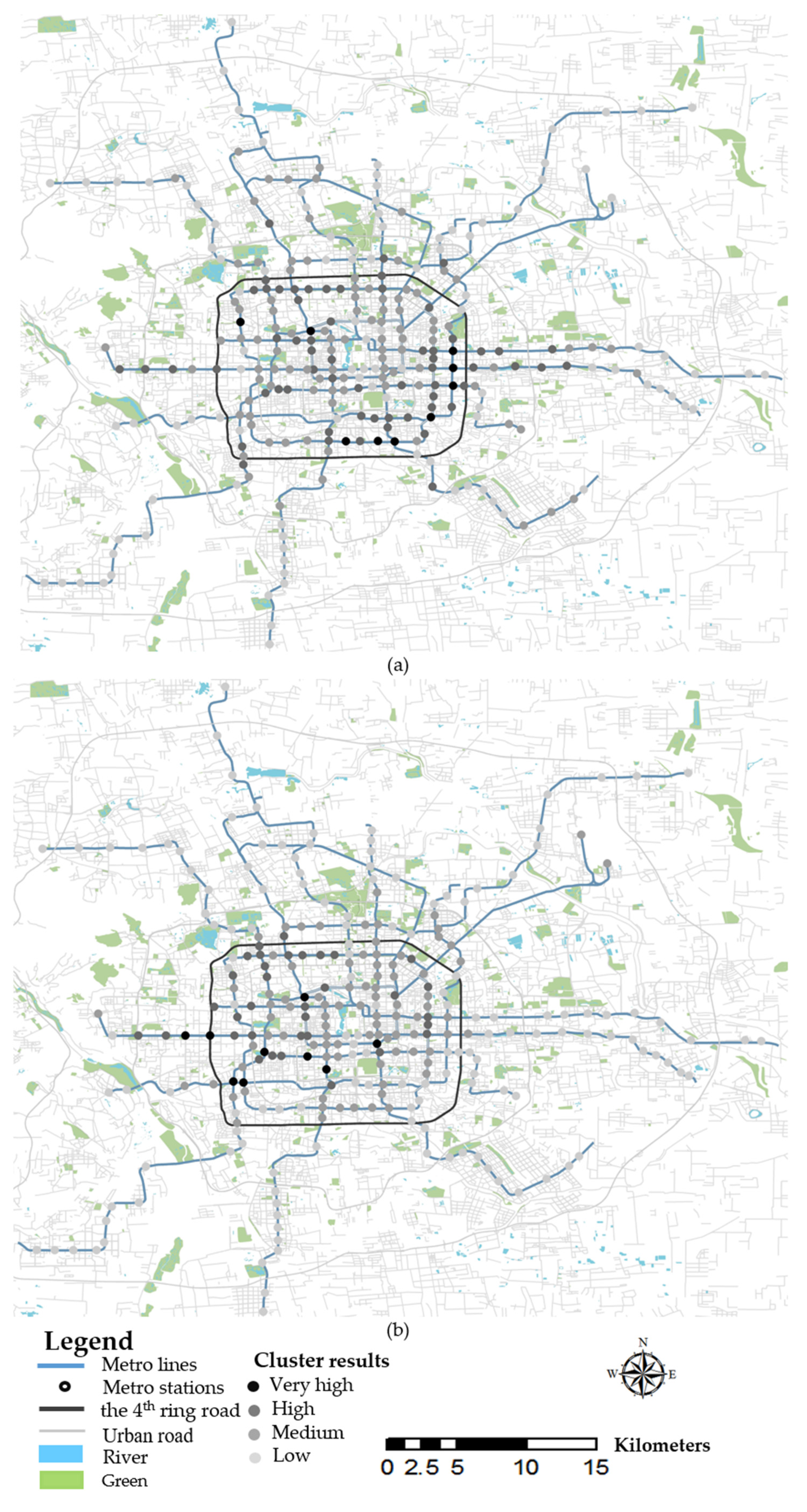
| Bike Sharing | Taxi | ||||||||||||||||
|---|---|---|---|---|---|---|---|---|---|---|---|---|---|---|---|---|---|
| Sun et al. [47] | Faghihimai et al. [42] | Zhao et al. [43] | Ji et al. [31] | Wang et al. [44] | El-Assi et al. [41] | Zhang et al. [48] | Zhao and Li [32] | Erdoğan et al. [30] | Yang et al. [34] | Qian and Ukkusuri [23] | Li et al. [35] | Wei et al. [46] | |||||
| Independent variables | |||||||||||||||||
| Sociodemographic variables | Population | ● | ● | ● | ● | ● | ● | ● | ● | ● | ● | ||||||
| Age | ● | ||||||||||||||||
| Income | ● | ● | |||||||||||||||
| Household density | ● | ● | |||||||||||||||
| Metro station characteristics | Distance to CBD | ● | ● | ● | ● | ● | |||||||||||
| Elevated station | ● | ||||||||||||||||
| Transfer station | ● | ||||||||||||||||
| Terminal station | ● | ||||||||||||||||
| Ridership of metro | ● | ● | ● | ||||||||||||||
| Public transit | Bus lines | ● | ● | ● | ‘ | ● | |||||||||||
| Bus stops | ● | ● | ● | ||||||||||||||
| Bike stations | ● | ● | ● | ||||||||||||||
| Metro stations | ● | ● | ● | ● | ● | ● | |||||||||||
| Bus accessibility | ● | ● | |||||||||||||||
| Metro accessibility | ● | ● | |||||||||||||||
| Land use (POIs) | Job-housing balance index | ||||||||||||||||
| Land use mix types | ● | ● | |||||||||||||||
| Restaurants | ● | ● | ● | ● | |||||||||||||
| Commercial Enterprises | ● | ● | ● | ● | ● | ● | |||||||||||
| Parks and greens | ● | ● | ● | ● | ● | ● | ● | ||||||||||
| Residential | ● | ● | ● | ● | ● | ● | ● | ● | ● | ||||||||
| Office | ● | ● | ● | ||||||||||||||
| Shopping malls/Retails | ● | ● | ● | ||||||||||||||
| Schools | ● | ● | ● | ● | ● | ● | |||||||||||
| Airports | ● | ||||||||||||||||
| Hospitals | ● | ● | ● | ||||||||||||||
| Tourists attractions | ● | ||||||||||||||||
| Roadway infrastructure | Street intersections | ● | ● | ||||||||||||||
| Arterial road length | ● | ● | |||||||||||||||
| Branch road length | ● | ● | ● | ||||||||||||||
| Road networks density | ● | ● | ● | ● | |||||||||||||
| Street light/trees | ● | ||||||||||||||||
| Bicycle facility | ● | ● | ● | ● | ● | ● | |||||||||||
| others | Parking availability | ● | ● | ||||||||||||||
| Data and methodology | |||||||||||||||||
| Dependent variables | Ridership | Usage rates | Ridership | Ridership | Ridership | Ridership & OD | Ridership | Mode selection | Ridership | Pickup & Drop-off | Ridership | Ridership | Ridership | ||||
| Data source | GPS data | GPS data | GPS data | Smart-card data | GPS data | GPS data | Smart-card data | Survey data | GPS data | GPS data | GPS data | GPS data | GPS data | ||||
| Model | GAMM | LMM | OLS | GWR | OLS & NB | OLS | SLM | MNL | OLS | OLS | GWR | GWR | GWR | ||||
| DBS | Taxi | |||||
|---|---|---|---|---|---|---|
| Trip Time | Transfer Ratio | Trip Direction Ratio | Transfer Ratio | Trip Direction Ratio | ||
| Morning Peak (MP) | 17% | TTM | 53% | 13% | TTM | 55% |
| FTM | 47% | FTM | 45% | |||
| Evening Peak (EP) | 8% | TTM | 48% | 16% | TTM | 46% |
| FTM | 52% | FTM | 54% | |||
| DBS | Taxi | ||||||||
|---|---|---|---|---|---|---|---|---|---|
| Low | Medium | High | Very High | Low | Medium | High | Very High | ||
| C1 | C2 | C3 | C4 | C5 | C1 | C2 | C3 | C4 | |
| MPTTM | 23 | 68 | 95 | 143 | 262 | 7 | 23 | 54 | 105 |
| MPFTM | 19 | 64 | 142 | 82 | 243 | 5 | 21 | 51 | 95 |
| EPTTM | 15 | 59 | 138 | 73 | 226 | 8 | 34 | 73 | 101 |
| EPFTM | 17 | 63 | 84 | 128 | 218 | 7 | 31 | 66 | 94 |
| Number | 117 | 102 | 25 | 26 | 5 | 143 | 99 | 27 | 6 |
| Percent | 42.5% | 38.9% | 7.3% | 9.5% | 1.8% | 52.0% | 36.0% | 9.8% | 2.2% |
| Items | Variable | Description and Notes | VIF | Min | Max | Mean | S.D. |
|---|---|---|---|---|---|---|---|
| Dependent variable | DBS transfer ridership | Number of bicycles at the buffer zone of the metro station (numbers) | 2.00 | 304.00 | 55.47 | 106.45 | |
| Taxi transfer ridership | Number of taxis at the buffer zone of metro station (numbers) | 1.00 | 169.00 | 21.20 | 61.19 | ||
| Ridership Characteristics | Trip time: EP/MP | =1 if the transfer ridership is during EP, =0 if the transfer ridership is during MP | 1.00 | 0 | 1.00 | 0.50 | 0.50 |
| Trip direction: FTM/TTM | =1 if the transfer ridership is from the metro (FTM), =0 if the transfer ridership is to the metro (TTM) | 1.00 | 0 | 1.00 | 0.50 | 0.50 | |
| Socioeconomic values | Population density | Density of jiedao population at 3000 m buffer zone (numbers/km2) | 3.93 | 209.22 | 75025.47 | 11813.86 | 11406.55 |
| Gender ratio: male | Proportion of male population in jiedao at 3000 m buffer zone (percent) | 1.93 | 0.48 | 0.62 | 0.53 | 0.03 | |
| Housing price | Average housing price at 3000 m buffer zone (yuan/m2) | 3.90 | 27406.00 | 135258.00 | 76023.46 | 24805.06 | |
| Metro station characteristics | Located in urban area | =1 if the metro station is in urban area, other =0 | 3.81 | 0 | 1.00 | 0.52 | 0.50 |
| Contain hot commuting lines | =1 if the metro station contains the hot commuting line (the average daily passengers of the metro line is more than 323,100), other =0 | 1.45 | 0 | 1.00 | 0.45 | 0.49 | |
| No. of metro lines | Number of metro lines in the station (numbers) | 1.31 | 1.00 | 3.00 | 1.21 | 0.43 | |
| No. of entrances | Number of entrances in the station (numbers) | 1.25 | 1.00 | 12.00 | 4.12 | 1.79 | |
| No. of nearby metro stations | Number of other metro stations at 3000 m buffer zone (numbers) | 6.97 | 1.00 | 21.00 | 9.08 | 5.07 | |
| Bus transit accessibility | No. of bus stops | Number of bus stops at 500 m buffer zone (numbers) | 1.34 | 1.00 | 14.00 | 8.51 | 2.35 |
| Length of bus lines | Length of bus lines at 3000 m buffer zone (km) | 3.05 | 41.25 | 501.39 | 22.17 | 103.69 | |
| Motorization service | No. of parking lots | Number of vehicle parking lots at 3000 m buffer zone(numbers) | 6.47 | 23.00 | 680.00 | 250.38 | 180.30 |
| Land use | No. of residences | Number of residence communities at 3000 m buffer zone (numbers) | 5.54 | 15.00 | 438.00 | 231.17 | 119.56 |
| No. of offices | Number of offices at 3000 m buffer zone (numbers) | 7.40 | 36.00 | 4673.00 | 1192.00 | 1062.93 | |
| No. of commerce | Number of commerce at 3000 m buffer zone (numbers) | 8.65 | 29.00 | 8585.00 | 3003.60 | 2096.64 | |
| No. of schools | Number of schools at 3000 m buffer zone (numbers) | 6,67 | 8.00 | 245.00 | 144.82 | 70.84 | |
| No. of parks | Number of parks at 3000 m buffer zone (numbers) | 3.85 | 0.00 | 61.00 | 20.37 | 13.03 | |
| Roadway infrastructure | Length of arterial roads | Length of arterial roads at 3000 m buffer zone (km) | 4.47 | 24.95 | 403.83 | 146.31 | 76.92 |
| Length of branches | Length of branches at 3000 m buffer zone (km) | 8.16 | 35.69 | 249.04 | 138.96 | 38.49 | |
| No. of signalized intersections | Number of signalized intersections at 3000 m buffer zone (numbers) | 1.59 | 4.00 | 39.00 | 8.21 | 18.57 |
| DBS | Taxi | |||||
|---|---|---|---|---|---|---|
| coeff. | z-Value | P Value | coeff. | z-Value | p Value | |
| Constant | 2.003** | 2.409 | 0.016 | 0.273 | 0.371 | 0.710 |
| Ridership Characteristics | ||||||
| Trip time: EP/MP | −0.063*** | −4.982 | 0.000 | 0.179*** | 10.448 | 0.000 |
| Trip type: FTM/TTM | −0.107*** | −5.540 | 0.000 | −0.010 | −0.631 | 0.528 |
| Socioeconomic values | ||||||
| Population density | 0.0246 | 0.757 | 0.448 | 0.080*** | 2.155 | 0.003 |
| Gender ratio:male | −0.703 | −1.327 | 0.184 | −1.675*** | −3.511 | 0.000 |
| Housing price | −0.396*** | −3.066 | 0.002 | 0.196* | 1.712 | 0.086 |
| Metro station characteristics | ||||||
| Located in urban area | 0.007 | 0.205 | 0.837 | 0.054*** | 3.277 | 0.001 |
| Contain hot commuting line | 0.104** | 1.993 | 0.046 | 0.071*** | 3.381 | 0.001 |
| No. of metro lines | 0.083*** | 3.605 | 0.000 | 0.016 | 0.707 | 0.480 |
| No. of entrances | −0.073 | −1.283 | 0.199 | 0.108* | 1.676 | 0.093 |
| No. of nearby metro stations | −0.154* | −1.725 | 0.085 | −0.327*** | −4.016 | 0.000 |
| Bus transit accessibility | ||||||
| No. of bus stops | −0.141* | −1.775 | 0.076 | 0.191*** | 5.609 | 0.000 |
| Length of bus lines | −0.188*** | −2.714 | 0.006 | −0.046 | −0.749 | 0.454 |
| Motorization service | ||||||
| No. of parking lots | 0.035 | 0.419 | 0.675 | 0.429*** | 5.511 | 0.000 |
| Land use | ||||||
| No. of residences | 0.312*** | 2.928 | 0.003 | 0.206** | 2.177 | 0.029 |
| No. of offices | 0.224*** | 4.154 | 0.000 | 0.131*** | 2.771 | 0.006 |
| No. of commerce | −0.069 | −0.750 | 0.453 | −0.610*** | −7.076 | 0.000 |
| No. of parks | −0.071* | −1.770 | 0.078 | 0.012 | 0.267 | 0.710 |
| Roadway infrastructure | ||||||
| Length of arterial roads | 0.005 | 0.059 | 0.952 | 0.156*** | 4.677 | 0.000 |
| Length of branches | 0.527** | 2.023 | 0.043 | −0.091* | −1.819 | 0.068 |
| No. of signalized intersections | −0.259*** | −2.702 | 0.007 | 0.165** | 2.611 | 0.010 |
| Wy | 0.556*** | 27.811 | 0.000 | 0.519 *** | 24.237 | 0.000 |
| Log likelihood | −341.888 | −208.573 | ||||
| AIC | 727.777 | 461.147 | ||||
| R2 | 0.725 | 0.758 | ||||
© 2020 by the authors. Licensee MDPI, Basel, Switzerland. This article is an open access article distributed under the terms and conditions of the Creative Commons Attribution (CC BY) license (http://creativecommons.org/licenses/by/4.0/).
Share and Cite
Ni, Y.; Chen, J. Exploring the Effects of the Built Environment on Two Transfer Modes for Metros: Dockless Bike Sharing and Taxis. Sustainability 2020, 12, 2034. https://doi.org/10.3390/su12052034
Ni Y, Chen J. Exploring the Effects of the Built Environment on Two Transfer Modes for Metros: Dockless Bike Sharing and Taxis. Sustainability. 2020; 12(5):2034. https://doi.org/10.3390/su12052034
Chicago/Turabian StyleNi, Ying, and Jiaqi Chen. 2020. "Exploring the Effects of the Built Environment on Two Transfer Modes for Metros: Dockless Bike Sharing and Taxis" Sustainability 12, no. 5: 2034. https://doi.org/10.3390/su12052034
APA StyleNi, Y., & Chen, J. (2020). Exploring the Effects of the Built Environment on Two Transfer Modes for Metros: Dockless Bike Sharing and Taxis. Sustainability, 12(5), 2034. https://doi.org/10.3390/su12052034





